Natural silk fabric is very popular due to its amazing characteristics. Silk liked so much to people that he was learned to make a synthetic way. But this circumstance did not affect the high demands of the natural threads obtained from cocoons of a tute silkworm.

History
Silk - natural material, the production of which has no one millennium. It is assumed that Silk Matter began to be produced even to our era. Tit silk come from China. As the legend says, the 14-year-old wife of one of the first Chinese emperors once drank tea in the outdoor in the shade of the trees, and a cocoon silkworm fell into the cup. Under the influence of hot water from a cocoon, a strong thin thread came out.The spouse of the ruler got a thread and at that moment she was visited by the idea that from the contents of the cocoon, you can make a fabric, distinguished by beauty and durability. Soon, high-ranking faces of the state issued an order to grow silkworms. And later the machine was invented, and the silk raw began to be more active.
Simpultures strictly forbidden to sew silk outfits. This brilliant natural material has long been used in the sewing of outfits exclusively for the emperor's courtyard representatives. Especially in this regard, a red silk with a gold embroidery was appreciated.
The production of silk was carried out only in China, his secret was not disclosed under the fear of the death penalty. The larvae and silkworm cocoons, as well as the seeds of the tute tree, forbidden to be transported to other countries. With the development of trade, thin silk matter has become known to the whole world. However, China many centuries remained the only country where this natural material was produced on an industrial scale.
In Europe, acetate silk came up in Europe, a synthetic alternative to genuine silk fabric from China was invented. Now the production of the canvas is developed in Italy, France, England and Switzerland.
In all ages, the history of silk was shrouded in secret, connected with intrigues and sometimes - with mysticism. Genuine circumstances of its occurrence are not known to this day.
The history of artificial silk began in the 19th century, when the process of xanthymanning was developed. The technology was invented by the British Beevin, Cross and Bidll, although in Europe there were attempts to create an artificial belt.
To obtain synthetic material, wood ground washed in a solution of cautious soda. Then, other chemical compounds were added to another wet composition, due to which the Xantogeneration reaction occurred.
The resulting product was passed through a peculiar sieve, after which it was placed in sodium solution, zinc sulfate and sulfuric acid. So the threads and fibers were formed, and the synthetic silk raw began to produce on an industrial scale. The patent for its production was registered on September 30, 1902.
Types of silk fabrics
The range of silk matters determine the types of fibers, the weave of the threads, the properties of silk, the features of its production and appearance. Natural silk matter occurs two varieties: Malbury and Tussa.
Article on the topic: Winter knitting needles for women. Magazine with schemes
The highest quality is silk Mulber, who has no analogues . It is made from the filaments of a silkworm grown in artificial conditions. The whole process of obtaining material is carried out manually. Its processing occurs without the use of chemical products, so that natural brilliant material retains all its properties.
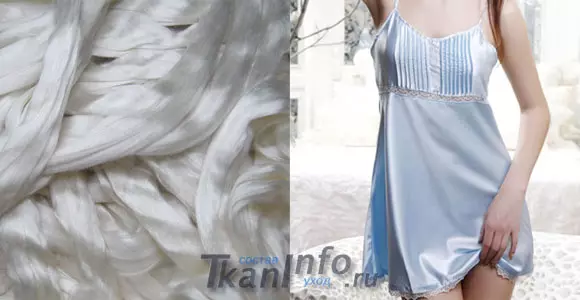
Truck grade, unlike Malbury, produce from the threads of the wild caterpillar-silkworm. Tussus is a red silk, sometimes brown or copper. It is used in the furniture industry for upholstery products, interior decoration or pillow filling. So that this cloth has acquired a more presentable look, it is bleaching.
These are natural types of silk, featuring the quality and method of production.
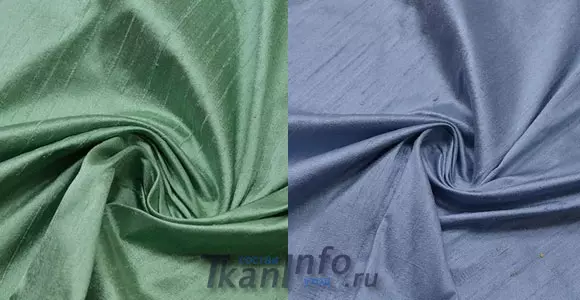
Also, the tissue is divided by types:
- Slopeful matter is a crepe-chiffon, crest-gorget.
- Semi-rapous fabrics - crea satin, tightness.
- Dense Silk Fabric Jacquard.
- Small canvas.
- Pile fabrics - velor velvet, velvet.
Silk fabric is classified depending on the production method. At the same time, each matter has its own, unique characteristics.
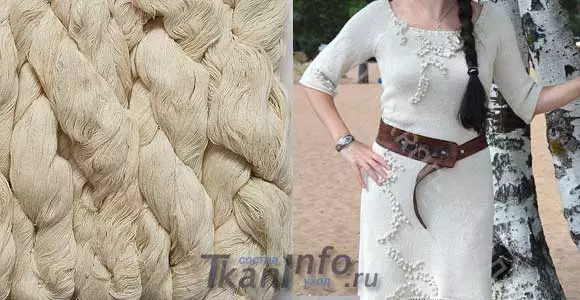
- Breeny silk consists of short pieces of fibers that are not cleaned. Fibers, components of raw silk, linse the outer and inner layers of the cocoon. Due to this arrangement of the thread of this type of web, they have bactericidal properties.
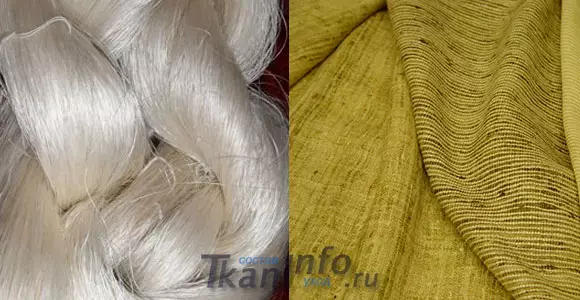
- Silk raw - high quality textile material. It is made from the caterpillar cocoon method of rewinding the thread or synthetic. Silk raw possesses such characteristics: smoothness, softness, elasticity, strength, good extension. Usually silk raw goes on the manufacture of dresses, sewing threads and other products.
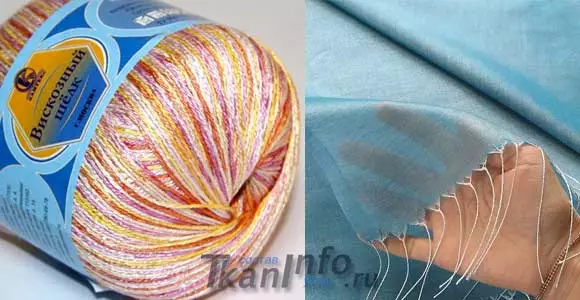
- Viscose silk is matterium usually linen, contains synthetic fibers. Thanks to modern production technologies, the viscose silk is now done almost indistinguishable from natural material. The viscose can be determined by the fiber burning method. This matter consists of cellulose, therefore it burns otherwise than the natural material consisting of protein compounds.
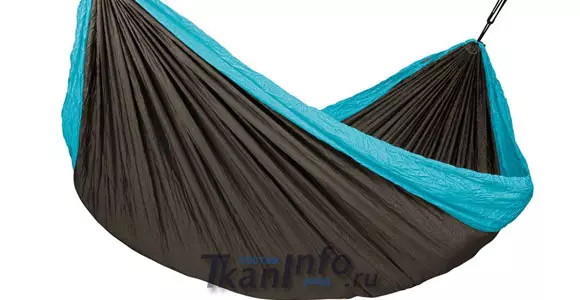
- Parachute silk is a cloth cloth used in a variety of spheres. A rather durable parachute silk - the material is translucent, painted in different shades, depending on the destination.
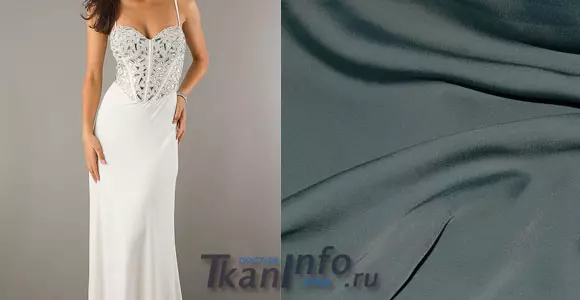
- Wet silk is made exclusively made of natural fibers. It is a safe and environmentally friendly material used in sewing elegant outfits: silk dresses, linen, costumes, shirts and ties. Also wet silk is used to upholstery elite furniture. Otherwise, wet silk material is called satin satin.
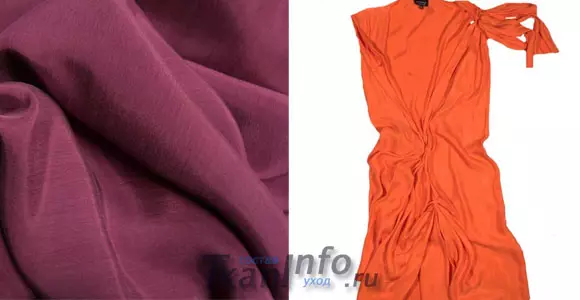
- Boiled silk linen material has a homogeneous matte surface. It is used for tailoring: silk dress, as well as suits and other outfits of boiled fabric type on recent designs of designers are now at the peak of fashion. Silk boiled material reminds suede in its appearance.
Composition and properties
In its chemical composition, natural material resembles hair or wool. By 97%, it consists of proteins, the rest - waxes and fats. Artificially obtained acetate silk consists mainly of cellulose with a slight content of chemical impurities.Article on the topic: how to make a paper cylinder: step-by-step instructions with a scheme and video
Silk fabric of natural origin Stand to acids, organic solvents and alkalis.
Natural material loses its strength at temperatures above 110 degrees or with direct effects of ultraviolet.
Silk matter is pleasant to the touch. It is a brilliant durable and soft material that can be painted in different shades. It is very wearless, it skips well and absorbs moisture. In the light, the thin fabric is beautifully overflowing.
From this matter sew both summer and winter things, because at any ambient temperature, the body is comfortable in them. In addition, natural silk has a disinfecting effect - especially the boree silk obtained from the protective fibers of the inner and outer layers. Therefore, silk matter is often used as suture material.
For disadvantages of silk matters, especially linen, can be attributed to the lightweight . If a silk dress is sewn from such varieties like a chiffon and crest, it almost does not occur due to elevated twisting the threads in the canvas. The appearance of spots on the surface of the fabric under the influence of moisture also relates to minuses. Such contaminants are easily removed by alcohol. The synthetic material is electrified, and in natural, there is no such feature.
Production
Caterpillar caterpillars are bred in large silkicultural farms. First, their eggs are placed in incubators. After the insect hatches, it is transferred to the feeders. When the silkworm grows, it is placed in the box where he starts his work on making a cocoon. It takes about 4 days. The finished cocoon is placed in boiling water, where it is unwound. It turns out a silk thread from 300 to 1000 meters long.
After special treatment, the thread acquires shine. If you need a cloth without shine, it is simply removed on one of the final stages of production. The threads are painted and tank from them tight silk, natural natural matter. On this, the production of silk ends.
Application
As already mentioned, the areas of use of this material are very extensive. Consider each of them in more detail.Finishing interiors
In the 90s of the last century, a new type of wall decoration appeared in Europe. To do this, wet silk was used - special plaster with natural fibers. Wet silk was used in the decoration of luxury premises. Now the wet silk form of the decor became more affordable.
On wet silk it is worth paying attention to owners of entertainment institutions. This material has an excellent texture, it does not burn and is not smoldering, so from the point of view of fire safety is ideal. In addition, the wet finishing material is very beautiful and durable.
Tailoring

Perhaps this is the most common area of silk material. For sewing clothes, both natural and acetate silk are used, quite slightly different in properties. The thin silk matter of the linen weave perfectly emphasizes the figure, convenient when sock and durable.
Article on the topic: How to make a paper fortune tile with your own hands in stages - photos, video
For the manufacture of wardrobe items, parachute silk is often used, characterized by high strength. Also, this species is used in the production of various products: tents, seat upholstery and furniture, etc.
Home textiles
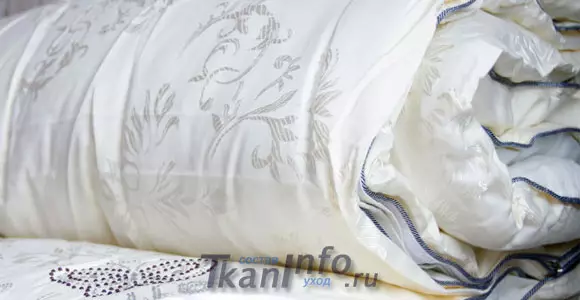
Beautiful brilliant cloth looks great in the interior. They sew curtains, bed linen, capes for furniture, bedspreads and much more.
Silk is absolutely not allergenic material. Dust pliers and bugs do not multiply on it. Therefore, people suffering from allergies, this thin fabric is best suited.
Medicine
The tute silk has the ability to absorb moisture in a much larger volume than other materials. At the same time, it is not at all wet to the touch. Therefore, it is actively used in medicine.This is an excellent suture material used in surgery. The suture of matter is not resolved up to 3 months. Also, suture silk causes a minor initial inflammatory reaction of lively fabric. Silk suture is used even in eye and neurosurgery.
Needlework

From this tissue make excellent souvenirs. In the embroidery of paintings, a tote silk or artificial is used. Arriving in the Vietnamese City of Dalat, tourists are not attended by the workshop of the embroiderers family. There are very expensive unique canvases embroidered by manually by natural silk threads on a transparent canvas.
Also, a bore silk (or other natural) is used in knitting. It is done by hand or on special machines sophisticated knitted things.
How to distinguish the material?
To determine that we are not acetate silk before us, namely natural material, you can use the combustion method. Artificial fibers will actively burn with a bright flame, the emitting smell of paper.If you set fire to natural silk material, it will smooth. In this case, you can feel the smell of burning hair.
In addition, it is possible to determine the silk by its soft texture, a shiny surface.
Care rules
Cloth of linen weave from silk threads requires special care. This brilliant material must be erased manually or with a special mode. Delicate things to wash is prohibited, it is better to give them to dry cleaning.
When washing, it should be separated by clothing in color: red silk is erased separately from white, etc.
When silk is still wet after washing, it is necessary to wrap it in a towel. As soon as the excess moisture is absorbed, the product should be put on a horizontal surface. Dryers to use forbidden.
Wet material can not be stroke. When silk dries, you can stroke it with an iron at low temperatures without steam.
Over the past millennia, nothing has changed in the fate of silk fabric: and in modern life it takes away from the last place, as in all the time of its existence. This popularity of gentle matter deserved not in vain. It is a suture, and dresses, and finishing material used with success everywhere.
